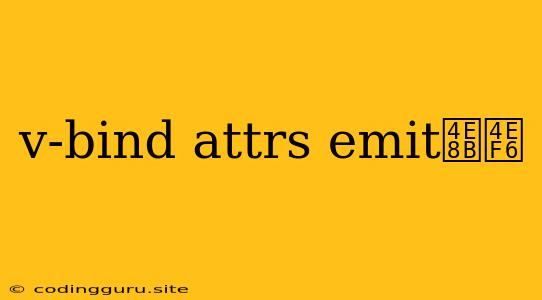Understanding v-bind, attrs, and emit Events in Vue.js
Vue.js, a progressive JavaScript framework, provides a powerful and flexible way to build interactive user interfaces. One of the key features that makes Vue.js so versatile is its component system. Components allow developers to encapsulate reusable UI elements and logic, enhancing code organization and maintainability.
When working with Vue.js components, you often need to dynamically manage attributes, pass data between components, and trigger custom events. This is where v-bind, attrs, and emit come into play. These directives and methods empower you to create robust and interactive components.
What is v-bind?
v-bind is a directive in Vue.js that lets you bind an HTML attribute to a data property within your component. It allows you to dynamically change the attribute's value based on the component's state.
Example:
This is a dynamic class example!
In this example, :class="activeClass" binds the class attribute of the <div> element to the activeClass data property. If activeClass is set to "inactive", the <div> will have the "inactive" class. However, if activeClass is changed to "active" dynamically, the <div> will dynamically update its class to "active."
What are attrs?
attrs is a special object in Vue.js components that contains all the attributes passed down from the parent component to the child component. It's useful when you need to expose certain attributes to child components, especially when you are using v-bind to pass attributes.
Example:
{{ $attrs.myAttr }}
In this example, the parent component passes a my-attr attribute with the value "hello" to the MyComponent child component. MyComponent can then access this attribute using this.$attrs.myAttr.
What are emit Events?
emit is a method in Vue.js components that allows them to communicate with their parent component by triggering custom events. This mechanism enables components to send data or signals upwards in the component tree.
Example:
In this example, the MyButton component emits a "click" event whenever its button is clicked. The parent component listens for this event using the @click directive and calls the handleButtonClick method.
When to Use v-bind, attrs, and emit Events
-
v-bind: Usev-bindwhen you want to dynamically bind HTML attributes to data properties in your component. This is especially useful for changing the appearance of elements based on component state. -
attrs: Useattrswhen you need to expose attributes passed down from the parent component to child components. This is useful when you want to manage attributes likeclass,id, or data attributes within nested components. -
emitEvents: Useemitto create custom events within components that allow them to communicate with parent components. This is essential for passing information or signals upwards in the component tree.
Example of Using All Three
{{ $attrs.myAttr }}
In this example, the parent component passes three things to MyComponent:
my-attrwith the value "hello" (usingv-bind)is-activewith the valuefalse(usingv-bind)- An event listener for "my-event" using
@my-eventand callinghandleMyEvent
Inside MyComponent, the component accesses my-attr through this.$attrs.myAttr and dynamically applies the active class based on isActive. Finally, it emits a "my-event" when the button is clicked.
Conclusion
v-bind, attrs, and emit events are essential tools in your Vue.js toolbox. Mastering these concepts will allow you to build more sophisticated and interactive components, making your application truly dynamic and responsive. By understanding how to bind attributes, manage attribute inheritance, and trigger custom events, you can effectively structure and connect components, building complex interfaces with ease.
